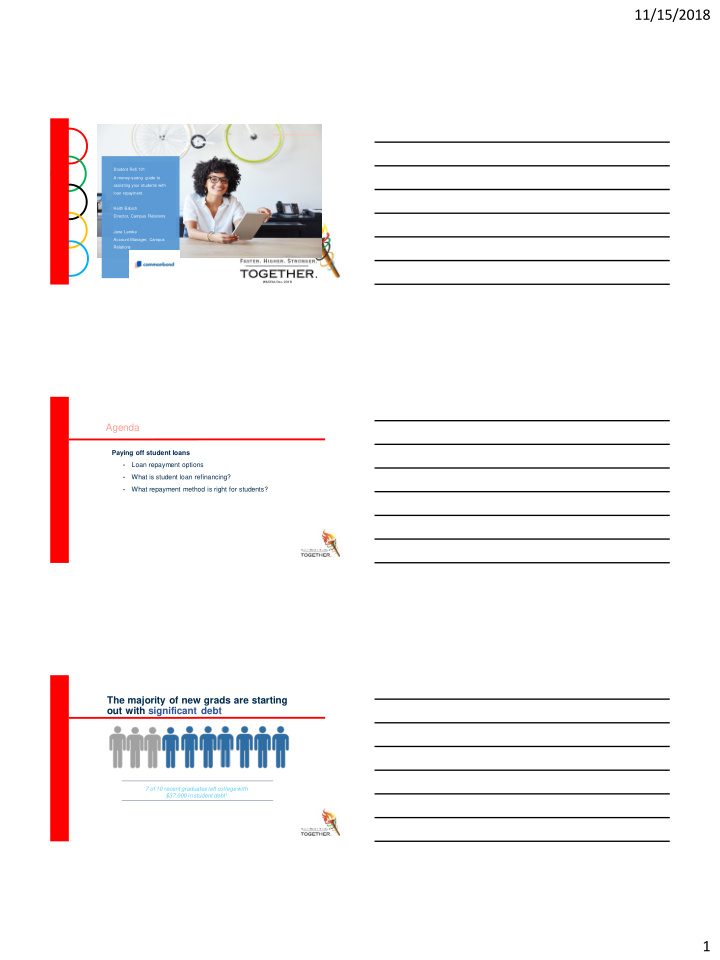



11/15/2018 Student Refi 101 A money-saving guide to assisting your students with loan repayment. Keith Babich Director, Campus Relations Jane Lemke Account Manager, Campus Relations Agenda Paying off student loans • Loan repayment options • What is student loan refinancing? • What repayment method is right for students? The majority of new grads are starting out with significant debt 7 of 10 recent graduates left college with $37,000 in student debt 1 1
11/15/2018 Average student debt by degree $35k $57k $56k $112k $176k $247k $250K $200K $150K $100K $50K $0K Undergraduate Graduate MBA JD MD DDS Paying off Student Loans Choice of employer has a large impact on the appropriate method of loan repayment 2
11/15/2018 Working for a non-profit employer Options for Federal Loans: - Income-driven repayment plans - Public service loan forgiveness For Private Loans: - Student loan refinancing Working for a for-profit employer Options for Federal loans: - Income-driven repayment plans - Standard repayment plans - Student loan refinancing For Private Loans: - Student loan refinancing Repayment Options for Federal Loans Income-driven repayment plans Your monthly payment is capped at a certain percentage of your income May be a good plan for those with a lower income who wouldn’t be able to afford standard monthly payments Pro: Keeps monthly payment low Con: Increases total cost of the loan Use these plans if pursuing PSLF 3
11/15/2018 Repayment Options for Federal Loans – Income Driven Plans Revised Pay As Y ou Pay As Y ou Earn Income Based Income Contingent Earn Repayment Plan Repayment Plan Repayment (IBR) Repayment (ICR) (REPAYE) (PAYE) Eligibility Direct Loan borrowers Direct Loan borrowers Direct Loan and FFEL Direct Loan borrowers borrowers (onlyplan for Parent PLUS loans) Monthly payment 10% of discretionary 10% of discretionary 10% of discretionary 20% of discretionary income income income if you borrowed on income or what you or after 7/1/14, or 15% if would pay on a 12 year older fixed plan adjusted for income Repayment period 20 years for undergrad 20 years 20 years if you borrowed 25 years (remainingbalance is loans, 25 years for grad on or after 7/1/14, or 25 forgiven after this time) or professional loans TAXABLE years if older TAXABLE TAXABLE TAXABLE Income requirement to None Y our income must be low Y our income must be low None enter plan compared to your eligible compared to your eligible federal student loan debt federal student loan debt Repayment Options for Federal Loans Standard repayment plans Repay your loan in full in 10-25 years based on type of loan Pro: Lower overall cost than income-driven plans Con: Higher monthly payment than income-driven plans Repayment Options for Federal Loans - Standard repayment plans Standard Graduated Extended Repayment Repayment Repayment Repayment period Pay off your loan in 10 Pay off your loan in 10 Pay off your loan in 25 years years years Monthly payment Same payment each Payments start low Can be fixed or month and go up every 2 graduated years Benefits Save money on Save now while your Generally lower interest vs. longer income is low and pay monthly payments plans more when your then any other plan income can handle it You’re betting on Drawbacks Highest monthly Highest total cost payments making more money No forgiveness later 4
11/15/2018 Repayment Options for Federal Loans Forbearance You can put your federal loans in forbearance, which pauses repayment completely Interest will continue to accrue and will be capitalized at the end of the forbearance period You can do this for up to 12 months at a time Increases total cost of the loan Repayment Options for Federal Loans Public Service Loan Forgiveness 5
11/15/2018 What about refinancing those student loans? What is student loan refinancing? Refinancing means taking out a new loan to replace an existing loan Lenders pay off existing loans, and create a new loan at a lower interest rate Borrowers can refinance federal, private, Parent Plus and previously consolidated student loans What are the benefits of refinancing? 6
11/15/2018 Refinancing helps your students save by giving them a tailored interest rate that is often lower than the rate on their existing loans. Savings Lower interest over the life of the loan Ease One lower monthly payment Protections Borrowers can defer payments if they return to school or lose their job No fees How do I know if refinancing is right for my students? 7
11/15/2018 When it’s wrong When it’s right Student did not graduate from a 4 Student should not be in an existing year, Title IV school with a Bachelors IDR program due to income or debt degree or higher load Student works for non-profit that Student has private loans that aren’t would be eligible for PSLF eligible for govt. programs Student has a low income compared Student meets refinancing criteria to their student loan debt Student wants to pay off debt quickly Student has low interest rate loans and reduce interest costs Thank you! Keith Babich Director, Campus Relations Keith@commonbond.co Jane Lemke Account Manager, Campus Relations Jane.Lemke@commonbond.co 8
Recommend
More recommend